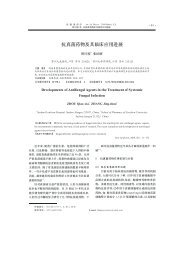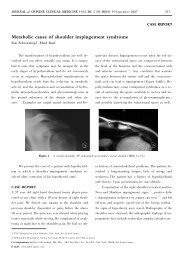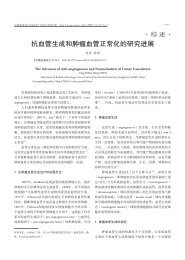PDF下载
PDF下载
PDF下载
Create successful ePaper yourself
Turn your PDF publications into a flip-book with our unique Google optimized e-Paper software.
-488- 心理科学进展 2009 年<br />
replication of the Harvey and Bryant (1999) study. Journal of<br />
Traumatic Stress, 20, 359–364.<br />
Meiser-Stedman, R., Dalgleish, T., Smith, P., Yule, W., &<br />
Glucksman, E. (2007). Diagnostic, demographic, memory<br />
quality, and cognitive variables associated with acute stress<br />
disorder in children and adolescents. Journal of Abnormal<br />
Psychology, 116, 65–79.<br />
Meiser-Stedman, R., Smith, P., Glucksman, E., Yule, W., &<br />
Dalgleish, T. (2007). Parent and child agreement for acute<br />
stress disorder, post-traumatic stress disorder and other<br />
psychopathology in a prospective study of children and<br />
adolescents exposed to single-event trauma. Journal of<br />
Abnormal Child Psychology, 35, 191–201.<br />
Meiser-Stedman, R., Yule, W., Smith, P., Glucksman, E., &<br />
Dalgleish, T. (2005). Acute stress disorder and posttraumatic<br />
stress disorder in children and adolescents involved in assaults<br />
and motor vehicle accidents. American Journal of Psychiatry,<br />
162, 1381–1383.<br />
Moore, S. A., & Zoellner, L. A. (2007). Overgeneral<br />
autobiographical memory and traumatic events: An evaluative<br />
review. Psychological Bulletin, 133, 419–437.<br />
Moulds, M. L., & Bryant, R. A. (2002). Directed forgetting in<br />
acute stress disorder. Journal of Abnormal Psychology, 111,<br />
175–179.<br />
Moulds, M. L., & Bryant, R. A. (2005). An investigation of<br />
retrieval inhibition in acute stress disorder. Journal of<br />
Traumatic Stress, 18, 233–236.<br />
Nixon, R., Menne, A., Kling, L., Steele, A., Barnes, J., Dohnt, H.,<br />
et al. (2008). Metacognition, working memory,and thought<br />
suppression in acute stress disorder. Australian Journal of<br />
Psychology, 60, 168–174.<br />
Osuch, E. A., Willis, M. W., Bluhm, R., CSTS Neuroimaging<br />
Study Group, Ursano, R. J., & Drevets, W.C. (2008).<br />
Neurophysiological responses to traumatic reminders in the<br />
acute aftermath of serious motor vehicle collisions using<br />
[ 15 O]-H2O Positron Emission Tomography. Biological<br />
Psychiatry, 64, 327–335.<br />
Ozer, E. J., Best, S. R., Lipsey, T. L., & Weiss, D. S. (2003).<br />
Predictors of posttraumatic stress disorder and symptoms in<br />
adults: A meta-analysis. Psychological Bulletin, 129, 52–73.<br />
Russell, M. C. (2006). Treating combat-related stress disorders: A<br />
multiple case study utilizing Eye Movement Desensitization<br />
and Reprocessing (EMDR) with battlefield casualties from the<br />
Iraqi War. Military Psychology, 18, 1–18.<br />
Salmon, K., Sinclair, E., & Bryant, R. A. (2007). The role of<br />
maladaptive appraisals in child acute stress reactions. British<br />
Journal of Clinical Psychology, 46, 203–210.<br />
Sattler, D. N., de Alvarado, A. M. G., de Castro, N. B., Male, R.<br />
V., Zetino, A. M., & Vega, R. (2006). El Salvador Earthquakes:<br />
Relationships among acute stress disorder symptoms,<br />
depression, traumatic event exposure, and resource loss.<br />
Journal of Traumatic Stress,19,879–893.<br />
Scholes, C., Turpina, G., & Mason, S. (2007). A randomised<br />
controlled trial to assess the effectiveness of providing self-help<br />
information to people with symptoms of acute stress disorder<br />
following a traumatic injury. Behaviour Research and Therapy,<br />
45, 2527–2536.<br />
Sinclair, E., Salmon, K., & Bryant, R. A. (2007). The role of<br />
panic attacks in acute stress disorder in children. Journal of<br />
Traumatic Stress, 20, 1069–1073.<br />
Tsolakidou, A., Trümbach, D., Panhuysen, M., Pütz, B., Deussing,<br />
J., Wurst, W., et al. (2008). Acute stress regulation of<br />
neuroplasticity genes in mouse hippocampus CA3 area —<br />
possible novel signalling pathways. Molecular and Cellular<br />
Neuroscience, 38, 444–452.<br />
Velden, P. G., & Wittmann, L. (2008). The independent<br />
predictive value of peritraumatic dissociation for PTSD<br />
symptomatology after type I trauma: A systematic review of<br />
prospective studies. Clinical Psychology Review, 28,<br />
1009–1020.<br />
Wittmann, L., Moergeli, H., Schnyder, U. (2006). Low predictive<br />
power of peritraumatic dissociation for PTSD symptoms in<br />
accident survivors. Journal of Traumatic Stress, 19, 639–651.<br />
A Review of Study on Acute Stress Disorder<br />
DU Jian-Zheng, XIA Bing-Li<br />
(Institute of Psychology and behavior, Education Science College, Henan University, Kaifeng, 475001, China)<br />
Abstract: Acute stress disorder refers to stress reactions that occur between 2 days and 4 weeks after an individual<br />
has experienced, witnessed, or been confronted by a traumatic incident which is a threat of death or serious injury of<br />
oneself or others. The symptoms of acute stress disorder are separation, reexperiencing, avoidance, and<br />
over-vigilance. This article reviews the previous relevant studies of acute stress disorder and overviews from the<br />
aspects of measurement evaluation methods, incidence, the relationship between posttraumatic stress disorder and<br />
trauma memories, mental intervention. At last, this article highlights its possible future study direction.<br />
Key words: trauma; acute stress disorder; posttraumatic stress disorder.
















